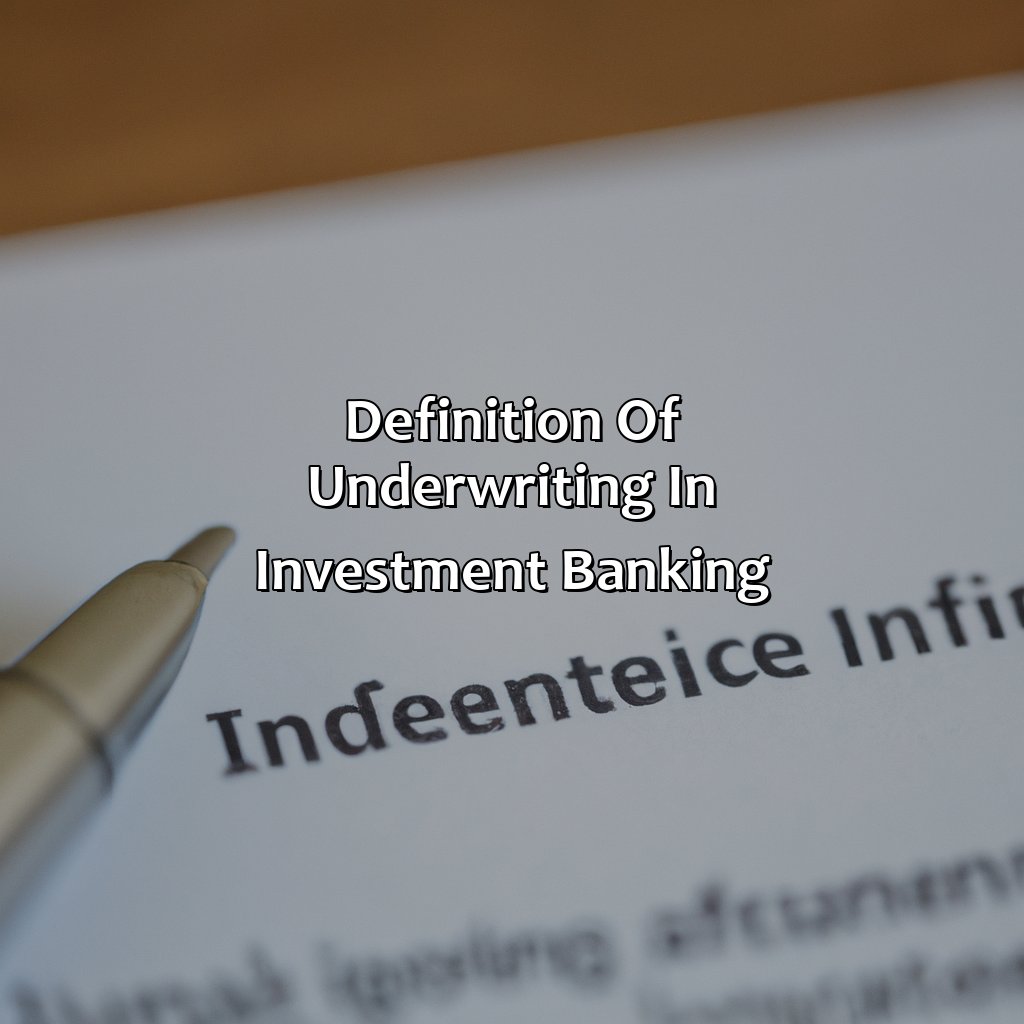What Is Underwriting In Investment Banking?
Key Takeaways:
- Underwriting in investment banking refers to the process of raising capital for companies by issuing securities such as stocks or bonds, and ensuring they are sold to investors.
- The role of underwriting includes assessing the creditworthiness and investment potential of a company, determining the appropriate securities to issue, and setting the price and timing of the offering.
- The importance of underwriting lies in providing companies with access to capital to finance their growth and operations, while also allowing investors to diversify their portfolios and earn returns. However, underwriting also carries risks such as the potential for losses due to market fluctuations.
Are you interested in investment banking but don’t know what underwriting is? Here you’ll find a comprehensive overview of this vital part of the banking process and learn why it’s important. You’ll have all the knowledge you need to help make the most informed decisions.
Definition of Underwriting in Investment Banking
Investment banking involves underwriting, which refers to the process of raising funds for companies. Underwriting in investment banking involves the purchase of securities, such as stocks or bonds, from a company that is looking to raise capital. The investment bank then sells these securities to investors, making a profit on the difference in price.
This process of underwriting involves a rigorous analysis of the company’s financial and market position, as well as the potential risks and returns for investors. The investment bank assumes the risk of any unsold securities, making it critical for the bank to accurately assess the demand for the securities.
One unique detail is that there are two types of underwriting: firm commitment and best efforts. In firm commitment underwriting, the investment bank guarantees to purchase all of the securities offered by the company, while in best efforts underwriting, the investment bank only agrees to sell as much of the securities as possible.
To ensure the success of underwriting, it is crucial for investment banks to have strong relationships with both the issuing companies and potential investors. Additionally, investment banks can employ various marketing strategies to increase demand for the securities and mitigate the risk of unsold securities.
Overall, underwriting plays a vital role in investment banking by allowing companies to raise funds and investors to access new investment opportunities.

Image credits: retiregenz.com by Yuval Jones
Role of Underwriting in Investment Banking
Underwriting plays a significant role in investment banking by helping companies raise capital through issuing securities such as stocks and bonds. During the underwriting process, investment banks evaluate a company’s financial position and reputation in the market to determine the level of risk associated with issuing securities. They then purchase the securities from the issuer and sell them to investors at a profit. This process helps companies to access funding to support their operations and growth.
In the underwriting process, investment banks also provide valuable advice to companies on how to structure their securities offerings and the pricing of those securities. Investment banks may also offer additional services like due diligence and marketing support to ensure a successful outcome. As such, underwriting plays a critical role in the growth and success of businesses.
Although underwriting is a standard practice in investment banking, there are unique details to consider regarding the size and complexity of the offering. For instance, larger offerings may require a syndicate of underwriters to spread the risk and offer more resources to support the deal.
Recently, a well-known company opted for an underwritten public offering of their stocks to attract investment. Despite having a significant market reputation, the company still required the underwriting services of an investment bank to help raise capital successfully. Without underwriting, this deal may not have gained investor confidence or achieved its intended outcome.

Image credits: retiregenz.com by Joel Duncun
Importance of Underwriting in Investment Banking
To grasp the significance of underwriting in investment banking and its advantages for companies and investors, you must examine two subsections.
- For companies, underwriting delivers lower risk, improved access to funding, and enhanced credibility.
- For investors, this provides an opening to put money into a business with less danger, bigger profits, and a chance to purchase shares before they are available to the public market.

Image credits: retiregenz.com by David Jones
Benefits for Companies
Underwriting plays a vital role in investment banking, offering multiple advantages to organizations. Here are some benefits that companies can reap through underwriting.
- It provides firms the capacity to raise funds by issuing bonds or stocks to the public.
- Underwriting involves risk management, which means managing uncertainties regarding financial deals. This, in turn, ensures businesses receive proper pricing and sales strategy advice.
- Underwriters help firms structure securities that match investor preferences and allow them to diversify their investor base.
- A successful underwriter fosters confidence among investors; this helps increase demand for securities issued by the firm.
Furthermore, it’s worth noting that enduring long-term relationships with reliable underwriters facilitates easier access to capital markets for future financing needs.
Pro Tip: Businesses should conduct comprehensive research on potential underwriters before selecting one. Identifying an underwriter’s capabilities and experience is crucial in ensuring they provide valuable insights into properly pricing a company’s securities and minimizing financial risks associated with capital market transactions.
Underwriting: because making money is great, but not losing it is even better.
Benefits for Investors
Investors can reap numerous benefits from underwriting in investment banking. The primary benefit is that they obtain a guarantee of purchasing a certain number of securities at a specific price. Additionally, they receive access to information related to the securities’ high or low-risk factors and how profitable they may be in the future. This knowledge enables investors to make informed decisions that can fetch them returns over time.
Another benefit for investors is that underwriters help prevent fraud attempts by vetting companies seeking funding before partnering with them. Through this collaboration, underwriters identify the companies’ strengths and weaknesses and ensure authenticity in their investment proposals.
Furthermore, investors can attain liquidity due to the active role played by underwriters in markets. Underwriters assist in identifying potential buyers who show interest during the IPO stage, which ultimately drives up stock prices.
Investors also get expert assistance from underwriters during the entire underwriting phase, leading up to the securities being offered on the exchange market. The guidance given helps them to select suitable securities within an optimal pricing range while minimizing risks.
Finally, owing to an underwriter’s vast network of contacts and reputation within an industry sector, investors may gain networking opportunities with other like-minded individuals seeking similar investments.
Pro Tip: Investors should always look out for reputable underwriting firms with well-established networks, as this enhances their chances of success amidst changing market conditions.
Underwriting in investment banking is like taking a shortcut through a dark alley – it could save you time, but there’s also a risk of getting mugged.
Risks of Underwriting in Investment Banking
Investment Banking Underwriting Risks
Underwriting in investment banking involves significant risks that need to be addressed. One of those risks is market risk, where the securities issued may not fetch the expected price. Another is credit risk, where the issuer might default on the obligations. The underwriters also face legal and regulatory risks as they are responsible for ensuring compliance with relevant laws and regulations.
To mitigate these risks, underwriters conduct extensive due diligence and assessment of the issuer. The underwriters must also have a solid understanding of the market conditions and investor sentiment to ascertain the appropriate pricing and demand for the securities. It is crucial to ensure that the issuer’s business model and management team can deliver the stated objectives.
Pro Tip: Underwriters must have a thorough understanding of financial and legal matters to make the right investment decisions and avoid unnecessary risks.

Image credits: retiregenz.com by Joel Washington
Examples of Underwriting in Investment Banking
Investment banks perform various services for companies to raise capital, including underwriting. This involves guaranteeing the sale of new securities and assuming the risk of buying the securities from the issuer to resell to investors. The investment bank makes money through fees and commissions on the sale. Underwriting in investment banking can take many forms, such as debt underwriting, equity underwriting, and mortgage-backed securities underwriting. Debt underwriting involves issuing bonds, while equity underwriting involves issuing shares in a public offering. Mortgage-backed securities underwriting involves bundling home loans into tradable securities. Underwriting in investment banking is a critical aspect of the capital markets that helps companies access capital at a lower cost.
A unique aspect of underwriting is that investment banks assess risk and determine the price of securities offered. This process involves analyzing the financials of the issuer and market demand for the securities. Investment banks use a range of strategies to reduce risks such as diversification and allocation of shares among institutional and retail investors. Underwriting also requires investment banks to follow regulatory and legal guidelines in the issuing process. By performing underwriting functions, investment banks help companies raise capital, manage risks, and expand their business.
According to a report by Statista, the underwriting revenue of investment banks globally in 2020 was $34.7 billion. This underscores the significance of underwriting in investment banking, both for the banks themselves and for the companies they serve.

Image credits: retiregenz.com by Yuval Duncun
Types of Underwriting in Investment Banking
Types of Underwriting in Investment Banking:
Underwriting is a crucial part of investment banking. It is a process by which an underwriter helps companies raise capital by issuing securities. Here are the different types of underwriting in investment banking:
| Type of Underwriting | Description |
| 1. Firm Commitment Underwriting | Underwriters commit to purchasing entire issue and assume risks. |
| 2. Best Efforts Underwriting | Underwriters try to sell the securities for the issuer but do not assume risk. |
| 3. All-or-Nothing Underwriting | The issuer sets the minimum amount of securities that must be sold, or the issue is canceled. |
| 4. Mini-Maxi Underwriting | The issuer sets a range for the total amount of securities to be sold and a limit on the amount from any one purchaser. |
It is essential to understand the differences between these types of underwriting to determine which one is the most appropriate for a given situation.
Moreover, it is crucial to note that underwriting also involves analyzing the risks associated with a particular security offering. Thus, underwriters have to assess the issuer’s financial standing, the market conditions, and other factors that may impact the success of the offering.
To succeed in underwriting, investment bankers must have a sound understanding of different underwriting types, as well as the risks and rewards they entail. They must also keep abreast of market trends to provide the best advice to their clients.

Image credits: retiregenz.com by Yuval Jones
Five Facts About Underwriting in Investment Banking:
- ✅ Underwriting in investment banking involves assessing and managing risk for issuing securities, such as stocks and bonds. (Source: Investopedia)
- ✅ Investment banks act as intermediaries between companies issuing securities and buyers, providing underwriting services to ensure the securities are sold successfully. (Source: Corporate Finance Institute)
- ✅ The underwriting process involves a thorough due diligence process to assess the creditworthiness of the issuer and the risk associated with the securities being issued. (Source: The Balance)
- ✅ Investment banks may underwrite securities on a firm commitment basis, meaning they agree to buy all the securities being issued and take on the risk themselves, or on a best-efforts basis, where they only agree to sell the securities to investors but do not guarantee their sale. (Source: Wall Street Prep)
- ✅ Underwriting fees can range anywhere from 1% to 7% of the total value of the securities being issued, depending on various factors such as market conditions and the complexity of the offering. (Source: Investopedia)
FAQs about What Is Underwriting In Investment Banking?
What is underwriting in investment banking?
Underwriting in investment banking refers to the process of providing financial support to companies or organizations that want to issue new securities, such as stocks or bonds. In exchange for this support, the investment bank receives a fee.
What is the role of an underwriter?
The underwriter plays a critical role in the issuance of new securities. They evaluate the company’s financial performance and determine the level of risk involved with investing in their securities. Once the underwriter agrees to support the issuance, they assume the risk of the securities until they can sell them to investors.
What are the different types of underwriting?
There are two main types of underwriting: firm commitment and best efforts. In firm commitment underwriting, the underwriter agrees to purchase all of the securities at a fixed price, regardless of whether or not they can sell them to investors. In best efforts underwriting, the underwriter acts as an agent for the company and tries to sell the securities to investors, but is not obligated to purchase any unsold securities.
What is an underwriting syndicate?
An underwriting syndicate is a group of investment banks that come together to manage the underwriting of a large securities offering. The lead underwriter takes on the majority of the risk, but the other members of the syndicate also provide financial support and sell the securities to investors.
What is the difference between underwriting and private placement?
Underwriting involves the issuance of securities to the public, while private placement involves the sale of securities to a limited number of private investors. Underwriting typically requires more extensive regulatory filings and disclosures, while private placement is less regulated and more flexible.
What are the risks associated with underwriting?
Underwriting involves significant financial risk, as the underwriter assumes the risk of the securities until they can be sold to investors. If the securities cannot be sold at a profit, the underwriter may lose money. There is also reputational risk associated with underwriting poorly-performing securities.


